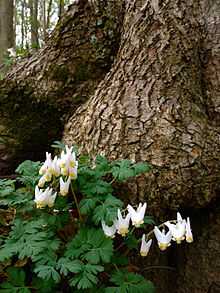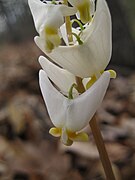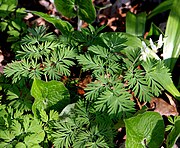Dicentra cucullaria
| Dicentra cucullaria | |
|---|---|
 | |
| Scientific classification | |
| Kingdom: | Plantae |
| (unranked): | Angiosperms |
| (unranked): | Eudicots |
| Order: | Ranunculales |
| Family: | Papaveraceae |
| Subfamily: | Fumarioideae |
| Tribe: | Fumarieae |
| Subtribe: | Corydalinae |
| Genus: | Dicentra |
| Species: | D. cucullaria |
| Binomial name | |
| Dicentra cucullaria (L.) Bernh. | |
Dicentra cucullaria (Dutchman's breeches) is a perennial herbaceous plant, native to rich woods of eastern North America, with a disjunct population in the Columbia River Basin.[1]
The common name Dutchman's breeches derives from their white flowers that look like white breeches.
Description
Height is 15–40 cm. The root is a cluster of small pink to white teardrop-shaped bulblets. Leaves are 10–36 cm long and 4–18 cm broad, with a petiole up to 15 cm long; they are trifoliate, with finely divided leaflets.
Flowers are white, 1–2 cm long, and are born in spring on flower stalks 12–25 cm long.
Dutchman's breeches is one of many plants whose seeds are spread by ants, a process called myrmecochory. The seeds have a fleshy organ called an elaiosome that attracts ants. The ants take the seeds to their nest, where they eat the elaiosomes, and put the seeds in their nest debris, where they are protected until they germinate. They also get the added bonus of growing in a medium made richer by the ant nest debris.
The western populations have sometimes been separated as Dicentra occidentalis on the basis of often somewhat coarser growth, but do not differ from many eastern plants in the Appalachians.
- Flowers and leaves
-

Buds
-
Almost opened flowers
-
Fully opened flowers
-

A flower dissected, showing four petals, two stamens, and pistil
-
Flowers
-

Flowers
-
Flowers and leaves
-
Leaves
-

19th century illustration
Medical uses
Native Americans and early white practitioners considered this plant useful for syphilis, skin conditions and as a blood purifier. Dutchman's breeches contains several alkaloids that may have effects on the brain and heart.
However, D. cucullaria may be toxic and causes contact dermatitis in some people.
References
- Bleeding hearts, Corydalis, and their relatives. Mark Tebbitt, Magnus Lidén, and Henrik Zetterlund. Timber Press. 2008.
External links
| Wikimedia Commons has media related to Dicentra cucullaria. |
| Wikispecies has information related to: Dicentra cucullaria |




